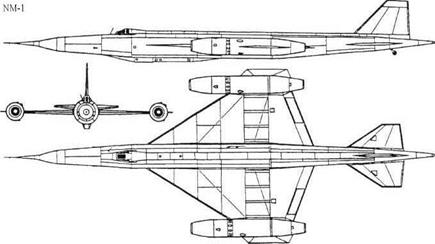TsybinNM-1

Purpose: To provide full-scale flight data to support the RSR.
Design Bureau: OKB-256, Podberez’ye, Director P V Tsybin.
In autumn 1956 funding was provided for a research aircraft designated NM-1 (Naturnaya Model’, life [like] model). This was to be a single flight article with an airframe based upon that of the RSR but simplified, with proven engines and stressed for lighter weights. It was completed in September 1958. On 1st October Amet-Khan Sultan began taxi testing, and he made the first flight on 7th April 1959, with a Yak-25 flying chase. The flight plan called for
take-off at 220km/h, but after a tentative hop Sultan actually took off at 325km/h, and jettisoned the dolly at 40m (131ft) at 400km/h (248mph). The dolly broke on hitting the runway (on later flights it had an automatic parachute). Sultan easily corrected a slight rolling motion, and flew a circuit at 1,500m at 500km/h before making a landing at 275km/h (90km/h faster than planned). Altogether Sultan and Radii Zakharov made 32 flights, establishing generally excellent flying qualities (take-off, approach and landing ‘easier than MiG or Su aircraft’) but confirming neutral or negative stability in roll.
The five-spar 2.5-per-cent wing had constant-chord ailerons and flaps which were unlike those of the RSR. On the tips were two Mikulin (Tumanskii) AM-5 turbojets each rated at 2,000kg (4,409 Ib) thrust, in simple nacelles without inlet centrebodies. The pilot sat in an ejection-seat under a very small canopy; the low-drag RS-4/01 canopy, resembling that of the RSR, was never fitted. Along the centreline were a sprung skid, hydraulically retracted into a long box, and a small tailwheel, while hydraulically extended skids were hinged under the nacelles. For take-offs a jettisonable two-wheel dolly was attached under the main skid. A door under the pointed tailcone released the braking parachute. After the taxi tests, following recommendations from CAHI (TsAGI) small extra wing surfaces were added outboard of the engines. The fuselage contained two kerosene tanks, a hydraulic-fluid tank and a nose water tank to adjust centre of grravity to 25.5 per cent of mean aerodynamic chord.
The NM-1 showed that the basic RSR concept was satisfactory.
|
||||||||||||||||||||||||||||||||||||||||||||
|












